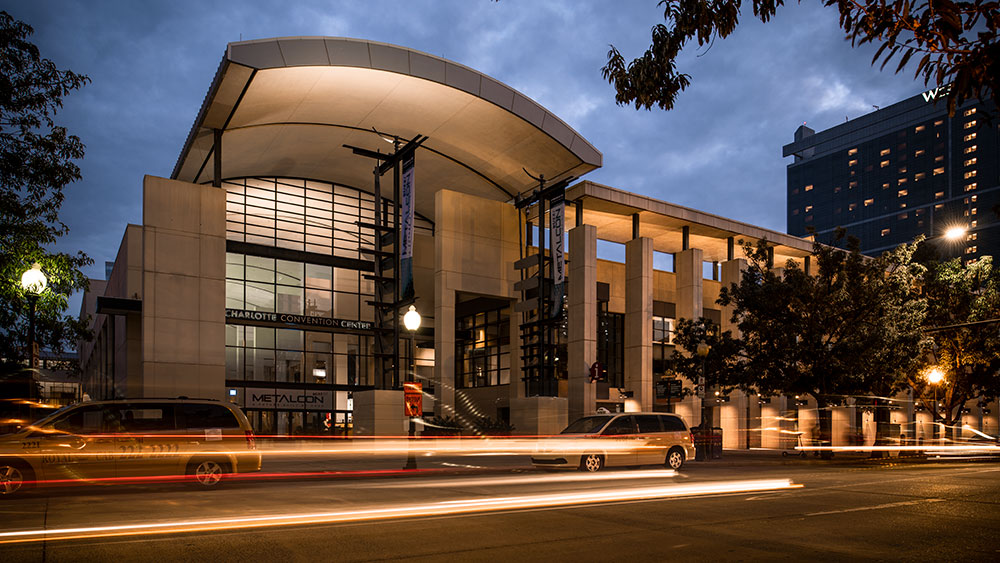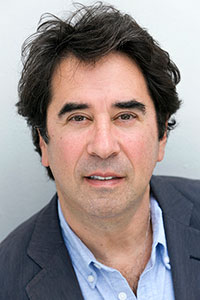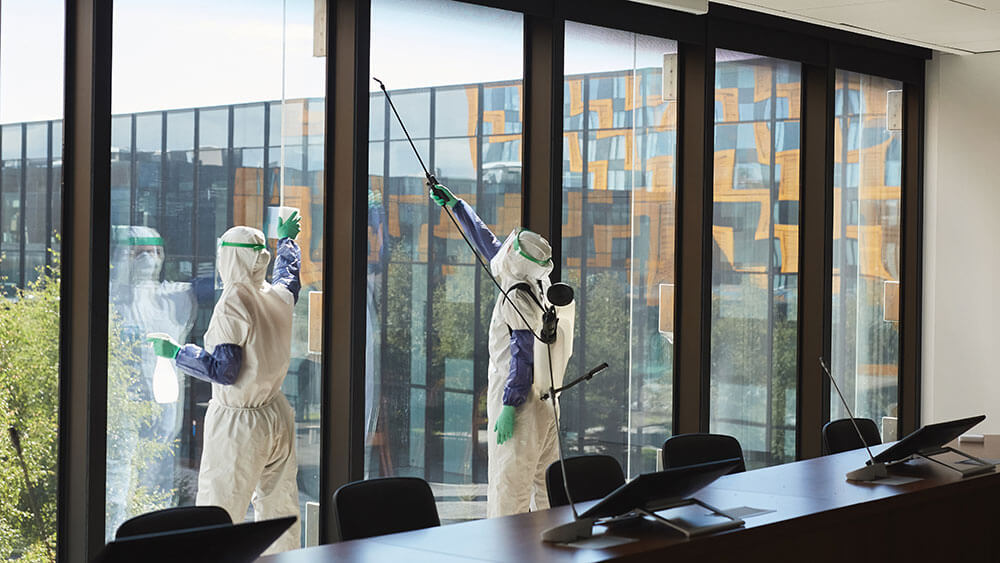
Venues, including the Charlotte Convention Center, are expanding cleaning protocols including air purification as research on the spread of the virus has shifted focus from surface contact to airborne transmission. (Courtesy Charlotte Regional Visitors Authority)
At the start of the pandemic, fears around the spread of COVID-19 spawned a cleaning frenzy among consumers and venues. Bleach and disinfectants disappeared from store shelves, and every public space, from hotels to restaurants, fired up electrostatic sprayers.
It didn’t take long for experts to rule out fomite transmission — the spread of disease via contaminated surfaces — as a significant contributor to the spread of COVID-19, yet a single-minded focus on cleaning has persisted. According to experts, “hygiene theater” — a term The Atlantic coined last year to describe “obsessing over risk-reduction rituals that make us feel safer but don’t actually do much to reduce risk” — is a problem because it distracts attention and resources from measures proven effective in mitigating transmission, like proper distancing, masks, and ventilation.
And the latter, especially, is lagging.
“We don’t have a single documented case of COVID-19 transmission from surfaces. Not one. So why, then, are we spending a small fortune to deep clean our offices, schools, subways, and buses?” Linsey C. Marr, Joseph G. Allen, and Charles Haas, wrote in a December Washington Post op-ed. “Shared air is the problem, not shared surfaces.”
Marr, a professor of civil and environmental engineering at Virginia Tech, studies the transmission of infectious disease via aerosols, including how diseases like COVID-19 spread in the built environment. She has been vocal about the important role air ventilation and filtration play in the spread of COVID-19 within indoor spaces, as well as her frustrations for those who continue to focus on more performative measures.
“‘Deep’ cleaning is not needed; ventilation and filtration are,” she tweeted on April 8, 2021. “On my recent flight, the airline touted its cleaning procedures for health and safety. Nothing about ventilation and filtration, which is what I wanted to hear about.”
She isn’t alone — many scientists, researchers, and public-health experts have been voicing similar concerns since early- to mid-2020. In December, the The CDC also has updated its guidelines to clarify that “in most situations, the risk of infection from touching a surface is low” and that the best solution to this is handwashing. And in early May, the CDC again updated its guidelines to emphasize the risk of airborne transmission, especially in indoor, poorly ventilated spaces.

“‘Deep’ cleaning is not needed; ventilation and filtration are,” tweeted Linsey C. Marr, a professor of civil and environmental engineering at Virginia Tech, on April 8, 2021. (Maridav/Adobe Stock)
Venue Ventilation
Marr and Allen were among 39 scientists who published an article in the May issue of the journal Science, urging what they called a “paradigm shift” in how both citizens and government think about air quality, given the “rapid growth in our understanding of the mechanisms behind respiratory infection transmission.” Governments have invested heavily in food safety, sanitation, and clean drinking water standards, they wrote, but “airborne pathogens and respiratory infections, whether seasonal influenza or COVID-19, are addressed fairly weakly, if at all.

Adrian Segar
Meeting designer and author Adrian Segar also has sounded an alarm over the lack of attention to venue ventilation and what he called a “misdirected” focus on surface cleaning. “Meeting industry venues that have remained open during the pandemic adopted cleaning and disinfecting everything in sight as a visible assurance that their venues were safe places to gather,” he wrote in an April 26 article posted on his website conferencesthatwork.com. But, “as we start thinking about returning to in-person events, it’s crucial to check that venues are upgrading their HVAC systems to handle potentially virus-infused air.” Segar, who has a Ph.D. in high-energy particle physics, noted that he is not an HVAC engineer, but became familiar with ventilation systems when he owned a solar manufacturing company in the 1980s.
Instead of using foggers and installing plexiglass — which can actually make things worse by blocking ventilation, according to aerosol scientists — experts say money is better spent on upgrading HVAC systems. Studies have long shown that ventilation plays a key role in mitigating not just COVID-19, but diseases like measles and tuberculosis.
Current ventilation standards “are bare minimums not designed for infection control or health promotion,” said Allen, Washington Post op-ed co-author and an assistant professor of exposure assessment science and director of the Harvard Chan School’s Healthy Buildings Program.
Guidance published in February 2021 by the California Department of Public Health made a similar point: “Existing ventilation requirements, such as those established in the California Building Code … were not intended to control exposures to small aerosols of hazardous infectious agents such as COVID-19.”
Additionally, the American Society of Heating, Refrigerating and Air-Conditioning Engineers (ASHRAE) Epidemic Task Force noted in an April 2021 update that airborne transmission of COVID-19 is significant and updates to building operations, including heating, ventilating, and air-conditioning systems, “can reduce airborne exposures.” The task force advises using MERV-13 or -14 filters in HVAC systems, among other measures — advice that the Occupational Safety and Health Administration has included in its list of COVID-19-related recommendations.
Earlier this year, Segar began reaching out to industry contacts and meeting professionals on social media, asking for examples of venues and properties that have implemented or are implementing ventilation upgrades to satisfy interim guidelines such as those published by ASHRAE and the California Department of Public Health. “To date,” Segar wrote in April, “I have been informed of only one venue—a California hotel property that installed MERV-13 filters.”
Healthier Standards
One growing avenue for change is the creation and adoption of more comprehensive standards that address building health and safety beyond sanitation, including a new rating created by the International WELL Building Institute (IWBI). Allen was one of 600 global physicians, environmental and behavioral scientists, designers, and business leaders from 30 countries who were part of a IWBI’s COVID-19 task force, which was convened last March. The IWBI WELL Building Standard, a set of guidelines designed to ensure the health and wellbeing of the people who use buildings, already included standards for the delivery of fresh air and building ventilation.

Allen Hershkowitz
The task force’s objective was not only to stress-test the WELL standards against the threat of COVID-19, but to create a streamlined set of guidelines that could be swiftly implemented during the pandemic. The result was a new safety rating, which rests on a subset of the more comprehensive WELL building standards and is “designed to be more or less a fast track,” said Allen Hershkowitz, environmental science advisor to the New York Yankees. Hershkowitz, formerly a senior scientist of the National Resources Defense Council, served on the IWBI COVID task force and is co-chair of the WELL Advisory on Sports and Entertainment Venues.
In July 2020, IWBI released the WELL Health-Safety Rating for Facility Operations and Management, well as guidance from WHO, the CDC, ASHRAE, ASTM International, and other global agencies. Last August, New York’s Yankee Stadium became the first sports and entertainment venue to achieve the WELL Health-Safety Rating seal, and since then, more than a billion square feet of space has been enrolled in the WELL Health-Safety Rating program. Locations include the AT&T Stadium in Dallas, Cleveland’s Quicken Loans Arena, and banks, schools, and office buildings in 12,000 locations and 88 countries.
The IBWI Health-Safety standards don’t supplant the kinds of sanitation and cleaning measures that venues have adopted into their protocols, including the GBAC STAR Facility Accreditation Program — they go beyond them. Last November, GBAC and IWBI announced a joint initiative that makes the GBAC STAR Facility Accreditation, awarded to nearly 2,000 venues — dozens of convention centers among them — an official path to the WELL Health-Safety Rating. The GBAC STAR accreditation counts toward a third of the criteria needed to achieve the IWBI rating.
Before Yankee Stadium reopened this spring, a team of epidemiologists from the New York State Department of Health inspected the facility from top to bottom, Hershkowitz said. There are places in the stadium, including the clubhouses and locker rooms, where the level of sanitation is “literally like a hospital operating room — what we call ‘biological clean,’” Hershkowitz said. “This is going to become the new normal in terms of cleanliness,” he added. “Things are not going back.”
‘Airborne and Interpersonal’
But most of the risk of COVID-19, he added, “is airborne and interpersonal.” The standards included in the WELL Safety-Health Rating go beyond ensuring clean air and surfaces. “When you’re talking about wellness, you’re not only talking about adding a MERV-13 air filter,” he said. “No matter how much you clean a venue, and lock down a venue, you’re going to have a situation where people are coming in and out. The potential for community transmission is very hard to control.” An effective health and safety plan for a venue “needs to include essential health services and community health and safety collaborations.”
The IWBI Health-Safety Rating encompasses an “extraordinarily diverse” set of protocols in categories including emergency-preparedness programs, health-service resources, and stakeholder-communication tactics, in addition to sanitation and air- and water-quality standards, Hershkowitz said. The holistic approach not only addresses the safety of the people coming into the venue, but also considers the people who work there, and includes policies like sick leave.
The IWBI rating represents a new way of thinking about public health and our environment, Hershkowitz said. In February 2020, “the world changed and suddenly our sensitivity to the health impacts of our surroundings was transformed. If there is one thing we’ve learned from the pandemic, it’s that we’re all connected,” he said.
“Most obviously, economic health is dependent on human health and frankly, human health is dependent on planetary health. The origination of this virus is a result of larger ecosystem behaviors — climate change, deforestation, the wildlife trade … where the food is coming from. I think if nothing else, we’re really starting to understand our interconnectedness.”

Armies of cleaners have been deployed to disinfect surfaces at venues, yet the risk of surface transmission of COVID-19 is low. (Seventyfour/Adobe Stock)
A Venue Wellness Checklist
Jessica Cooper, chief commercial officer for the International WELL Building Institute, has worked as programs manager for the Urban Green Council, and as director of sustainability at Delos, which created the WELL building standards.

Jessica Cooper
We asked Cooper: If you were planning an event for a group of people, what questions would you ask a venue to make sure it meets health and safety requirements to prevent, as far as possible, the spread of viruses like COVID-19? Here is her response:
I’d look for the WELL Health-Safety seal, which would demonstrate that the venue had undergone third-party review to validate that evidence-based operational strategies had been successfully implemented to manage health-safety concerns within the venue.
If an event venue had not achieved the WELL Health-Safety Rating, I’d ask for more details about what procedures and protocols are in place to support the health and safety of event participants. It would be important to understand:
- how the facility manages air filtration and ensures adequate ventilation
- whether the facility had taken precautions to prevent Legionella disease after a substantial closure or period of decreased operations
- what protocols were being taken to reduce contact with high-touch surfaces
- whether there were plans to minimize respiratory particle exposure through the air
- how the space is cleaned and sanitized
- what kind of handwashing support is available within the facility
- what kind of emergency-preparedness programs are in place
The answers to these questions will help event managers know whether an event venue has prioritized the health and safety of event participants and taken the necessary steps to welcome their customers back into the space.
Barbara Palmer is deputy editor and Jennifer N. Dienst is managing editor at Convene.
